Boat range in ocean conditions is remarkably hard to predict but it’s just about guaranteed that your real range is far shorter than estimates or even careful measurement if it wasn’t done in real ocean conditions. Ocean swell slows boats remarkably. We had no idea how much impact this would have when we first got our boat. In addition, bottom condition is rarely perfect, the boat will get heavier over time as more gear and spares comes on board, the tanks are rarely empty, and wind and current further complicate things by having a very large impact, sometimes negative and sometimes positive.
When we first got our boat, the John Deere Marine team from headquarters came on board to do some instrumented testing on the 6068AFM75 M2 engine since, at the time, it was a relatively new variant of the venerable Deere 6068. The team did careful two way runs in the Puget Sound at all RPM levels from 900 through max rated RPM. I took the Deere data and curve fit it using Excel. Using this data, our range with a 10% reserve was around 1,400 nautical miles at wide open throttle of 9.5 kts, 3,790nm at 6.5 kts, 4,500nm at 6kts, and an incredible 6,770nm at 5kts.
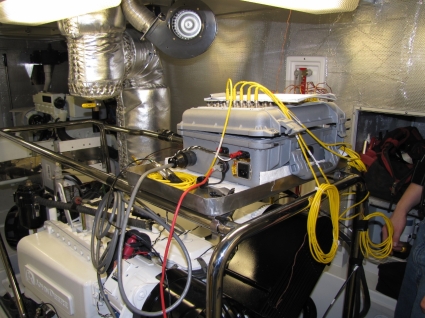
|
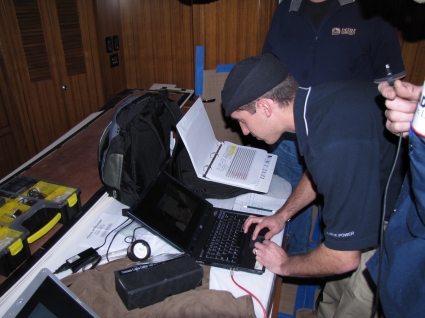
|
This data was carefully collected in controlled conditions but there are variety of reasons why it is only vaguely correlated to the actual fuel economy of the boat at sea. First, the data was based upon the originally specified fuel capacity of 1,870 gallons but boat builds vary and perhaps the original calculation wasn’t correct (it has since been updated). We’ve learned the only way to know the usable fuel capacity is to take the tanks down to the point where fuel no longer picks up. This is effectively empty since it’s the point where the engine will stop running. With the engine running on the day tank, the large side tanks can be completely emptied and then filled incrementally calibrating both the sight gauges and level sensors at the same time. Doing that, we know the usable capacity on our boat is 1,750 gallons.
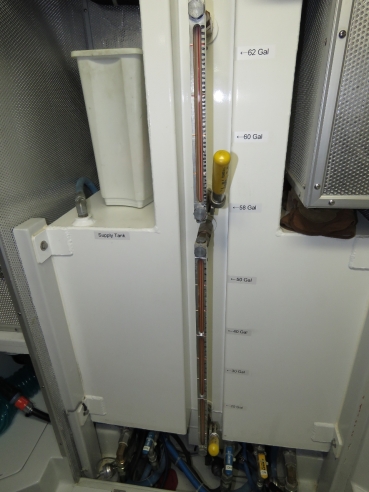
|

|
A far more significant factor is that the original instrumented sea trial was run on the flat waters of Puget Sound. Conditions actually can be quite rough there, but weren’t that day and, even if they were, it never has an ocean swell. The up and down of swell and wind waves can have a dramatic negative impact on fuel economy. What makes it even more challenging to really know the fuel burn on a given route is the possible impact of wind and currents. It could be positive and it could be negative but, either way, the impact can be surprisingly strong. We’ve ended up determining the best way to understand a boat’s range is to do a few trips that are on the long side so that many different conditions are encountered, and use the mileage achieved on those trips to understand the average burn. Then take some worst-case wind and current condition and use that mileage to compute the worst-case burn.
In Dirona‘s case the real ocean-crossing results are significantly different from the carefully controlled sea trial data that we initially calculated. Using a 3,023 nm crossing of the Indian Ocean and a 3,691 nm run across the South Atlantic, we see our real ocean-crossing range at 6.5 kts is 2,100 nm on our 1,750 gallon tanks with roughly a 200-gallon reserve. Slowing to 6.0 kts gives us a 2,500 nm range.
Three observations jump out when considering these real world data points:
- The actual range is very different than what was expected from careful, two-way sea trials. At 6.5 kts we have a 2,100-nm range where the expected range was 3,790, and at 6.0 kts our range is 2,500 nm compared to the expected range of 4,500. The actual boat range was only 55% of the predicted range. Even very carefully measured data if not over longer periods in the ocean, can’t be trusted when thinking through how far the boat can go in real ocean conditions.
- With real-world range numbers ranging between 2,100 and 2,500 nm when holding back 200 gallons of reserve, how did we do the two crossings of 3,023 and 3,691 nm? No surprise, we carried deck fuel to get the additional range we wanted.
- The absolute amount of fuel consumed on these two very different trips of 19 days and 25 days, differing in distance by nearly 700 nautical miles, was almost identical. Why would such different trips consume the same amount of fuel? It’s because we adjust our speed to match the fuel we have on board and the distance we have left to travel. Because we aim to finish the trip with the same reserves, the two trips end up identical in fuel burn, but the longer trip was run 8% slower.
The first observation is a caution when you are planning a long-range trip on a boat that is new to you. First get some sea-time in the boat so you know the real range and allow sufficient reserves to cover possible inaccuracies in your measurements over longer periods.
The second observation leads to a common quote from aviation. The only time a pilot has too much fuel is when the plane is on fire. It’s very difficult to have too much fuel or excessive range. Fuel is safety in that even very negative conditions won’t consume the reserve. Once in the tender we carefully consumed less than half of our fuel load when heading up an inlet. We turned around at less than half burn knowing we had plenty of fuel for the long return to our boat. But, we had damaged the prop right near the halfway point. It wasn’t badly damaged and didn’t really slow the boat that much but, on the way home we learned an important lesson. Fuel burn was 30% to 40% higher due to the damaged prop. It was a reminder that mechanical problems can substantially impact fuel economy.
Fuel is also option value. If weather conditions change or other reasons favor changing destinations, having more fuel on board might allow the change. Fuel also allows more speed. For a given trip, more fuel allows more speed up to the maximum speed of the boat. For very long runs, a small amount more fuel can greatly shorten the trip. We generally believe that shorter trips are safer trips and less time at sea reduces the likelihood of unpredicted unsafe weather conditions.
The second observation is we clearly used deck fuel since, in both example trips, we far exceeded the range of our 1,750 gallon fuel tanks at any reasonable speed. Fuel bladders make good sense for long trips in small boats. It’s a way of getting more range (which might only be needed a handful of times during your ownership of the boat) without giving up very large amounts of interior storage, living, and mechanical spaces. Fuel is amazingly large. Here’s what our inside-the-boat fuel loads looks like in 40 gallon drums:
In small boats, interior space is always at a premium so it makes sense to use deck fuel to get the extra range when needed. We carry 600 gallons in two large tanks that fill our cockpit. We covered these ATL fuel bladders in detail in “Fuel for the Crossing“.
I like these bladders because they are strong. I’ve seen race cars equipped with ATL fuel cells hit cement walls at 200 mph and then flip the entire length of the front straight without fuel leaking or catching fire. ATL makes a good product. I like where we have them in the cockpit, because it’s as close to the waterline as possible, reducing the negative impact the deck fuel has on boat stability. And, since they completely fill the space and are firmly attached to the boat, they never shift. Large shifting fuel loads can be dangerous.
With this additional fuel on board and using the real ocean fuel economy numbers from above and the same 200 gallon reserve, we have a range of 3,328 nm at 6.0 kts. That’s a great distance and certainly more than is absolutely needed for most common ocean crossings. But, 6.0 kts is a bit slow. If we speed up to 6.5 kts, we get a range of 2,747 which, again, is quite adequate.
However, the 3,023 nm Indian Ocean crossing and the 3,691 nm South Atlantic passage are both examples of “more really is better”. For the Indian Ocean crossing, we wanted to go a bit faster than 6kts. Having another 360 gallons on board would allow us to increase our speed 8%. In the second example, having an additional 360 gallons on board would allow us to stretch out our range at 6.0 kts from 3,328 nm to 3,890 nm.
Is 8% faster or 17% further worth it for finding a way to carry another 360 gallons? Dirona clearly doesn’t “need” either but we couldn’t resist. But where to carry that extra fuel? We have read about several cases where fuel bladders mounted on the foredeck came free in heavy water due to wave action and just the difficulty of securing a bladder to the flat fore-deck surface with no walls. We placed the third tank in the Portuguese bridge area.

|
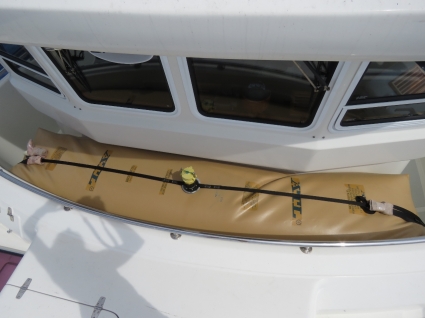
|
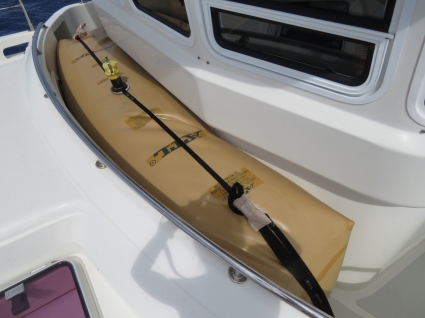
|
Above you can see we have effectively filled the walkway with a fuel bladder. The bladder fits tightly and is well secured so, like the cockpit tanks, it can’t move. This placement for the tank protects it from wave action and allows us to make the tank very secure. And while we can’t use the Portuguese bridge with the bladder in place, it doesn’t block the door to the foredeck or either pilot house door.
The only downside of this tank placement is that nobody makes a tank that would fit. But we still liked the idea so we contacted ATL and they said it would be no problem at all. In fact they sent me pictures of some of the custom tanks they have done over the years. The most amazing was a massive tank that would likely just barely fit on a football field. ATL assured us that they could easily build the bladder and it would be as strong as the two we already we have been using. I asked for a quote and it was substantially more than a standard sized bladder of similar dimensions, but less than double, and we really wanted it :-).
We elected to have ATL manufacture the bladder for us and have it shipped to Fiji where we were at the time. The bladder was designed, built, and shipped on schedule and we have used it three times so far. (The first was a test run when crossing the Tasman Sea.) When the forward bladder is not in use, it folds up small and takes up a tiny part of the corner of the fly bridge brow where we stow the other two bladders.
We don’t often use the bladders, when we do, we appreciate the increased range and speed. Being able to do trips approaching 4,000 nautical miles or to run a bit faster has worked out really well. And we’ll definitely be using all three bladders for our upcoming 2,900nm Atlantic Ocean crossing from Newport to Ireland.
More detail on our fuel bladder system is at

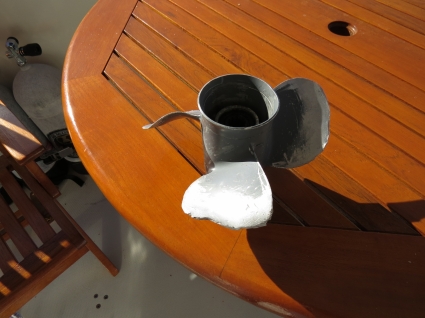
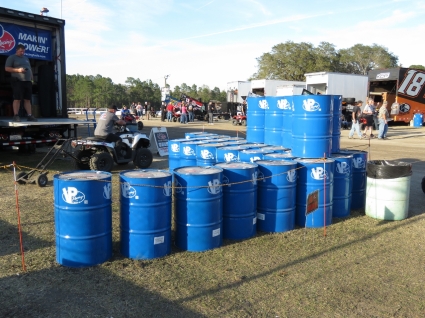
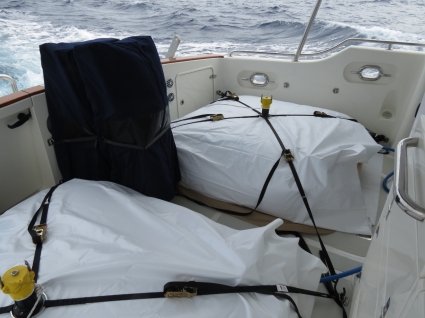
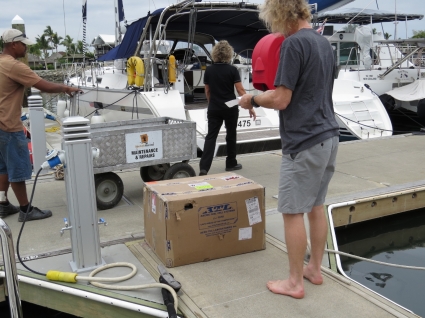
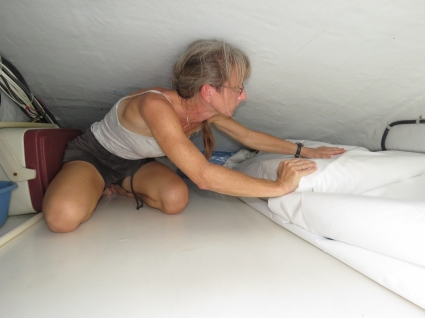
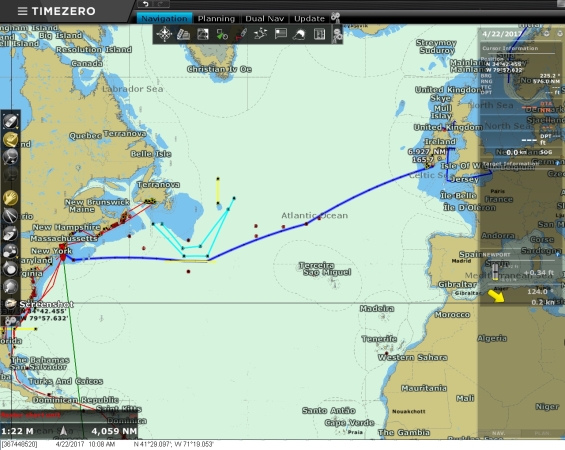
Hi James…I’ve been following this post with great interest, and I have a quick question—is your Portuguese bridge fuel cell set up to pump into your fuel manifold the same way as your cockpit cells? Great blog…I learn A LOT!
Yes, that’s right Matt. I’ve got two hoses with cam locks on either end. One for the fwd tank and one for the two aft tanks. Because there is only one bulkhead fitting, you can only hook up either the aft pair or the forward tank at one time. Once the hose is on, you can pump either both aft or the single forward without leaving the inside of the both.
Hello,
Just out of curiosity how far would your range be at 5knots with only the 1750 gallons of fuel and how much with the bladers?
The range is without deck fuel is pretty respectable. At 6.5 to 7.0 kts, it’ll do 2,500 nautical miles with the built in tanks. With deck fuel it’ll do 4,000 nautical miles. We’re not willing to slow down to 5 kts but the range is wildly improved down there.
I was curious about how far the nordhavn can go, but you are right the gain in range at 5 knots probably wouldnt be worth the time spent at sea.
We’re never run that speed for long range ocean crossing always preferring to go a bit faster so we have no experience. But, on flat water, slowing down to 5 kts would extend the range 50%. The improvements in real ocean conditions will be less but it will still be substantial.
Very nice write up, and details. I like the way you placed your blades on the boat.
Bladders, not Blades.
Yes, the bladder positioning works our well. They are very secure and don’t shift even in rough water. The big ones are right at the water line so don’t raise the center of gravity much. It seems to work well.
Thanks for another great article – the point you bring up about mechanical damage affecting fuel usage is one many people don’t think about. With the tender, do you have the option of manual operation (oars)?
Do you have a plan for how to respond to major engine problems mid-ocean? I know the likelihood is significantly reduced with your maintenance schedule and attention to small problems before they become big, but it is still non-zero.
We do have oars in the tender but an 850 lb tender (with no people in it) and no oar locks is not a high performance rowing scull. It would take a very long time to get anywhere. To be honest, we’re not super happy about not having reasonable backup options in the case of power failure in the tender. We have talked about bringing our Honda 2.3 hp with us for our longest trips but haven’t done it.
On Dirona, if we take prop or mechanical system damage, we have the wing engine as backup. The wing design is one of the strengths of the Nordhavn design. The wing has it’s own fuel tank, own transmission, it’s own shaft, and it’s own prop. Our main engine is full electronic whereas the the Wing is a very simple mechanically injected engine with very low power density (40hp from 2 liters). It’s not fast but we have used it in light winds and medium swell and it’ll do 3.5 kts when running at a reduced power level that it can support for 24×7.
The most likely fault mode in open ocean is to get tangled in fish net or other fishing related lines. That’s one of the reasons why I really like the wing design of having a completely independent and redundant mechanical system. We also have diving equipment on board so could dive the boat in calm conditions to remove most types of tangles. The final defense is we try to carry way more fuel than we need for the trip which allows for more speed but might allow us to get to still get to the destination running slowly in some failure modes.
It’s hard to have enough redundancy and backup in small boats. Dirona is reasonably well protected but the tender is exposed and there are times when we are in the tender 40 miles from Dirona in secluded areas. We’re not entirely happy about the redundancy on the tender but it’s hard to come up with adequate solution for a 12′ RIB.
Great write up, James and Jennifer! I appreciate the detail you put in to these and hearing your thought process clearly laid out.
I’m sure your preparation for the upcoming Ireland trip will ensure smooth sailing!
Thanks Nick!
How often do you need to run the generator on a trip like this? I know your alternators do most of the work but is there a fuel burn amount you use for the generator? 1.5 gph etc? Genny for the stove and washer an hour a day maybe?
We now never need to run the generator when at dock or when underway. The approach is written up in more detail here: //mvdirona.com/2014/08/a-more-flexible-power-system-for-dirona/
The basic approach is to have enough inverter capacity on board to run all appliances including HVAC, oven, dryer, and even the SCUBA compressor. When people think of inverters, they assume that it means you are running off batteries. Certainly you can but the most common configuration is we have a power source. Underway, it’s 9kw of alternator capacity running off the main engine. On shore power, it might be 50 hz or 60hz power and it might be 240V or 120V depending upon where we are and we use that to charge the batteries and run the boat off inverter capaicty. A additional upside of this approach is rather than needing a power source that delivers the peak power requirements of the boat (or pops a breaker), we only need the power source to deliver the average power requirements of the boat and breakers never are overloaded.
Clearly power produced, whether produced by the main engine or the generator, has a fuel cost. In the very early days we used to extend our range by not running the air conditionoing system. We eventually concluded that was nuts. The entire inside of the boat would end up with a salt film on every surface and the master stateroom was as high as 88F even with good ventilation.
We decided we had the boat for enjoyment rather than fuel economy and we now run the air conditioning at all times unless conditions are excellent and the weather is good. Even on our 3,700 nm South Atlantic run, we just ran the air conditioning 24×7 and enjoyed the crossing. The cost is that we would have needed to run the boat just a small amount more slowly to cover the increase in house power loads.
The final question is which is more efficient? Should the power be generated by the main engine or the generator? We ended up deciding that wasn’t the right question and instead asked, which is easier and lower maintenance? Our conclusion is we run the main engine 24×7 on crossings so why run the generator at all? If you do run the generator 24×7, then you need to change the oil every 10 1/2 days. Longer crossings would require 2 oil changes and whatever other consumables the generator required. We’re already signed up for that on the main engine so we have it produce all the required power as well and we never run the generator when underway.
The decision to run the air conditioning does require more fuel but since we set our speed to be the burn rate that finishes the trip with our decided fuel reserve, the additional burn just translates to slightly slower. We would rather have a longer trip and be comfortable that trim some hours off and not be comfortable.
Ignoring all of the ‘downsides’ to running the genset for such a duration (such as running at potentially very low loads, the extra maintenance work, etc,), how big (or is there any?) is the fuel consumption advantage of having the main engine run the loads? I would think it’s more efficient to run the main engine a little harder than running 2 engines, one at admittedly fairly low loads and one at slight lower loads. Part of my brain is saying there is some level of inefficiencies happening with 2 engines running, but on the flip side, it may be much lower than I’m thinking – the scale up or scale out conundrum.
Some folks more energetic than I have tested it and report at high loads the generator is slightly more fuel efficient. At low loads, your intuition is correct and the single main engine wins. This is with respect to fuel economy only. My take is, when considering all other factors, running just the single engine is a win and that’t where we always are. When the main is on, the gen is not. When the shore power is on, the gen is not.
We chose to only run the generator when other power sources are not available.
Great info, thank you. Couple of questions…..
There appears to be c35 x 40g drums. Are these US or IMP gallons?
How do you successfully empty the last drops of fuel, and do you have to prepare the bladders in any way, to fold them up? How the h*ll do you neatly fold up things like that? Thanks for the continuous stream of really interesting stuff.
Tim asked “There appears to be c35 x 40g drums. Are these US or IMP gallons?” That’s my Canadian upbringing coming out. Drums of roughly this size are used throughout the world. In Canada they are often referred to as 40 gallon drums but they are actually around 50 gallons US. These particular drums are full of the Methanol that powers the World of Outlaws Sprint Cars. As I recall the specified size of these drums is 55 US gallons.
You were asking how do we get the last bit of fuel out of the bladders in order to fold them up small. We have a neat trick for this. It’s common to use a portable pump to pump fuel into the fuel tank opening. The downside of this approach is the fuel tank is exposed to the possibility of water ingress and you need someone out on deck. We have a permanent bulkhead fitting that is connected to our fuel manifold. So, we just use quick connects (cam lock fittings) to connect a hose between the tanks and the bulkhead. Then the tanks can be pumped out using the main boat fuel transfer pump from inside the boat. This ensures that all fuel being taken from the tanks goes through a large Racor FBO-10 filter. It also allows us to use the heavy duty fuel transfer pump. This pump can put a slight negative pressure on the bladders and it does a very good job of sucking them down flat so hardly any fuel remains. this makes folding easy and keeps the overall package quite light. As you probably guessed, even small amounts of residual fuel gets heavy fast.
Great post James. I really appreciate the technical and practical advice you have been given us these past couple of months. Your Youtube video on some of the special features you have added with the electronics and fuel processing was great! Wishing you and Jennifer much success for your upcoming voyage to Ireland.